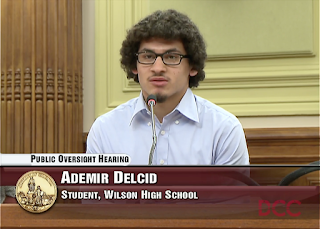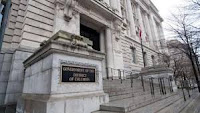Today’s blog comes to you as the first installment in our team’s analysis of Mayor Bowser’s proposed DC Budget for 2017. The Mayor’s proposal is now before Council where, through upcoming budget hearings and advocacy meetings, it will be debated and revised by Council Committees before it goes to a vote in May.
In the next few weeks, we'll be providing a deeper dive into each of our budget asks. We encourage you to follow along with our budget asks and talking points, and then join us at the Wilson Building to testify about your particular concerns at DC Council budget hearings.
Transportation Support - $950,000 (Not included in the Mayor’s proposed FY17 budget)
In the next few weeks, we'll be providing a deeper dive into each of our budget asks. We encourage you to follow along with our budget asks and talking points, and then join us at the Wilson Building to testify about your particular concerns at DC Council budget hearings.
Transportation Support - $950,000 (Not included in the Mayor’s proposed FY17 budget)
As we highlighted last year, the cost of transportation continues to be a pervasive barrier to the success of older youth (22-24) in re-engaging and maintaining engagement in educational opportunities. Unlike their younger colleagues (ages 5-21), who have access to the Mayor’s signature Kids Ride Free program, older youth must rely on their own, often limited, incomes or the support of their LEAs and programs to cover the cost of transportation.
Earlier this year, DCAYA conducted a survey in collaboration with Raise DC’s Disconnected Youth Change Network (DYCN), and found that 54% of respondents 22-24 reported spending over $30 a week or $120 a month travelling to and from their programs. Additionally, over half of the older youth surveyed reported spending 45% or more of their weekly income getting to and from their educational programs. 83% of these youth reported spending around one-fifth or more of their weekly income getting to and from their programs; notably 55% of youth spending this much live in Wards 5, 7, and 8.
An additional investment of $950,000 would ensure that these youth who have overcome multiple barriers to re-engage in their education at a Local Education Agency (LEA) would be able to attend school without the persistent worry of how they will afford to get there. To include the full breadth of youth pursuing their high school diploma or equivalent through District-funded schools (LEAs) and GED programs (CBOs), a total investment of $2.2 million is necessary.
The mayor’s proposed budget includes an allocation of $4.9 million to the DC Trust in FY2017, including afterschool and summer community-based programming. As initial allocations go, this is the strongest we’ve seen in years, and when mid-year reprogrammed funds are included, about steady with what overall out-of-school time (OST) grants over the course of fiscal years have been. While encouraging, we see this investment as a glass “half full”.
The DC Trust’s annual share of funding for OST is a direct reflection of the value we as a District place on our kids in the hours after school and in the summer, and that share has declined by more than half from 2010 to the present year, resulting in only a quarter of the locally-funded slots for afterschool and summer learning that were there for kids just six years ago:
If we are serious about providing safe, youth-friendly opportunities focused on improving outcomes and quality of life for all our children now and in future, we must reverse these trends. With a $10 million allocation to the DC Trust for OST programming in FY2017, and a commitment from leaders to the development of a dedicated funding stream, we would be back on track to serve up to four times as many children and youth with quality expanded learning opportunities.
Educational Data Capacity - Maintain the $1.1 million allocated in the Mayor’s proposed FY17 budget
We greatly appreciate that the mayor’s proposed budget includes $1.1 million to keep DC’s Statewide Longitudinal Education Data System (better known as the SLED database) stable and fully staffed. SLED has been a critical tool in transforming the District’s approach to decision-making in education. While SLED on its own is a reliable and useful data warehouse, because of partnerships like those with the college access providers, OSSE staff have already started taking SLED’s utility to the next level – namely, to reach more audiences of education data consumers to create user-friendly tools for more networks and to support the use of SLED for data-driven decision making at all levels.
In addition to the important education research underway hinging on the availability and analysis of data from SLED, it’s also important to note that SLED plays a critical role in the development of a comprehensive and coordinated workforce development system. The District’s Draft WIOA State Plan outlines plans to create a uniform system of intake, assessment, and referrals that is predicated on the maintenance of SLED. As the District moves towards a career pathways approach to workforce development, it’s critical that data on a resident’s educational and workforce experience can be shared across systems and, eventually, be made accessible to providers to streamline the eligibility and assessment processes. As other agencies look to build out on the success of the District’s education database, maintaining staffing levels and quality within the SLED team is key. We encourage Council to hold this investment stable and ensure full operational capacity of SLED in the years to come.
Youth Workforce Development - $870,000-$1,000,000 (Maintain FY16 expenditures for in-school youth programming; the baseline amount is still being clarified)
As Latin American Youth Center youth Ademir Delcid shared with us a few weeks back, maintaining school-based workforce development programming is a critical component of the District’s youth workforce development system. Through academic enrichment, exposing youth to work readiness skills, and offering project-based learning, in school youth programming provides workforce development to students to help keep them engaged in high school and prepare them for successful postsecondary transitions.
As Latin American Youth Center youth Ademir Delcid shared with us a few weeks back, maintaining school-based workforce development programming is a critical component of the District’s youth workforce development system. Through academic enrichment, exposing youth to work readiness skills, and offering project-based learning, in school youth programming provides workforce development to students to help keep them engaged in high school and prepare them for successful postsecondary transitions.
Under WIOA, federal expenditures for in school programs will be reduced to a maximum of 25% of the District’s total federal allocation of $2.3 million annually. At this funding mark, in school youth services would be significantly reduced. DC’s Draft WIOA State Plan includes a proposed strategy to blend the District’s reduced in school allocation with funding that flows through the Rehabilitation Services Administration (RSA) to make all in school youth programs accessible to youth with disabilities. While this is an important step forward for the District in serving youth with disabilities, the capacity of the District's provider community to serve this population well is currently limited, and will require investments in training and technical assistance. DCAYA believes that current funding for in school programs should be maintained at $870,000, and additional funding should be allocated for capacity building within the District’s in school youth providers to ensure all DC youth have access to high quality and developmentally appropriate in school workforce training.
Youth Homelessness - $800,000 (2.3 million is included in the Mayor’s proposed FY17 budget)
(Corrected April 5, 2016. The DHS Budget book incorrectly stated the 2017 enhancement was $3.1 million.)
(Corrected April 5, 2016. The DHS Budget book incorrectly stated the 2017 enhancement was $3.1 million.)
The mayor’s proposed budget includes $2.3 million in new funding for homeless youth services. Since the passage of the 2014 End Youth Homelessness Amendment Act, local funding for homeless youth services has remained at $1.3 million per year, which in 2014 represented just a 15% increase to homeless youth resources from the budget passed in the previous year. It was a modest increase given the mandates of the Act, but at the time, we still had incomplete data to quantify the actual need. With the start of the annual Homeless Youth Census, we now know more.
The census data makes clear that we’ll need to scale up prevention services in the year ahead, as well as add to our supply of crisis beds and transitional and independent living spaces for youth, if we are to get to the point that actual youth homelessness in the District becomes rare, brief and non-recurring by 2020. We applaud the mayor for recognizing this need and urge the council to adopt a budget that includes this important investment. There will be additional details on the DHS budget in the coming few weeks!
That's all for now! Check back next week for a closer look at our first budget ask: expanded access to transportation supports for re-engaging youth.
The census data makes clear that we’ll need to scale up prevention services in the year ahead, as well as add to our supply of crisis beds and transitional and independent living spaces for youth, if we are to get to the point that actual youth homelessness in the District becomes rare, brief and non-recurring by 2020. We applaud the mayor for recognizing this need and urge the council to adopt a budget that includes this important investment. There will be additional details on the DHS budget in the coming few weeks!
That's all for now! Check back next week for a closer look at our first budget ask: expanded access to transportation supports for re-engaging youth.










